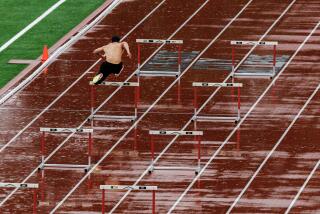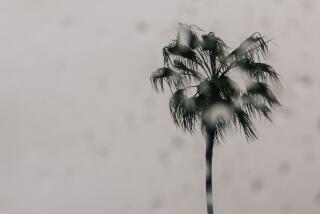Southern California storms save worst for last
The first rumblings sounded like cracking thunder.
“When you hear the boulders going ‘Bang, bang, bang,’ you know there’s going to be problems,” said Steve Eighart, who has lived in Orange County’s Silverado Canyon for 10 years, through the inevitable cycles of fire and flood that cut an edge of peril into Southern California’s genial landscape.
DEVELOPING: Frequent weather updates
Now, on Wednesday morning, as a raging Pacific storm battered the region, boulders were tumbling into the canyon. And as Eighart looked out the door, he saw water from swollen creeks cascading toward his house like a waterfall.
“I had water up to the windows in the back of the house,” he said a short time later. He spent the early morning hours building a makeshift dam to keep it out.
It was that kind of day across Southern California as a seventh straight day of pounding rain caused widespread flooding and damage. With the ground already saturated from the previous days of rain, nature delivered its strongest blow, a slow-moving, intensely wet storm spiked with wind, hail and thunder and wreaking havoc from San Diego to Ventura County.
It flooded downtown Laguna Beach with muddy goop, collapsed a concrete wall of Trabuco Creek in San Juan Capistrano and caused officials to release rising water behind the Whittier Narrows Dam in the San Gabriel Valley. A mudslide forced the evacuation of two homes in the Ventura County community of La Conchita, site of a tragic slide in 2005. Mud enveloped blocks of homes in the San Bernardino town of Highland, and San Diego’s Qualcomm Stadium flooded a day before the Poinsettia Bowl.
It got so wet in Laguna Canyon that animal rescue workers were forced to transfer seals and a seal lion to higher ground, and prized koi fish were swept to their deaths.
Since last Thursday, Laguna Beach recorded more than 9 inches of rain, and downtown Los Angeles was inching closer to setting a record for the wettest December in 120 years. Downtown had received at least 7 inches in the last 7 days alone, with the record for all of December being 8.77.
A pedestrian died Wednesday morning when she was hit by a car while crossing South Coast Highway in Laguna Beach, but it wasn’t clear whether the weather contributed to the accident. There were no estimates available of damage caused by the storm.
On Thursday, the storm system was expected to take a break – or, more accurately, to march east and out of California, although some lingering thundershowers were possible, forecasters said.
“They’ve just been in the line of fire from a series of rainfall cells,” said meteorologist Jamie Meier of the National Weather Service. The storms blew in on the jet stream off the Pacific, powered by a vortex of low pressure from the Gulf of Alaska and fueled by an airborne river of subtropical moisture from eastern Asia.
The rainfall hit hardest in Orange County and the eastern San Gabriel Valley, although it was intense at times throughout the region. As is often the case, some of the highest rainfall volumes came in mountain canyons, producing torrents of debris-clogged floodwater that turned roads into creeks and creeks into rivers.
And once again, the people who made the ultimate Southern California bargain, trading safety for beauty, permanence for transcendence, were presented with a reality check.
Tonalli Martinez’ family had lived in Los Angeles, Costa Mesa and Irvine before moving to Orange County’s Modjeska Canyon 13 years ago. The 18-year-old said that on most days, nothing beats the beauty of living in the canyons.
“In the summers, you have these beautiful days,” she said. “It’s pretty worth it. Then you get these days, when you’re trapped in your house and you need to go to work.”
Modjeska Canyon has a history of natural disaster, including periodic flooding and a devastating fire in 2007. The Martinez home is elevated, so the engorged river just a short walk away didn’t threaten it Wednesday as it did other homes. But that didn’t keep muddy water from ruining Guillermo Martinez’ workshop, where he makes Native American flutes and drums.
It was all enough to get Tonalli Martinez thinking about the trade-offs of living in the canyons.
“I feel like it’s worth it,” she said. “But then, at the same time, it’s inconvenient. But nature isn’t about our convenience. You just have to put up with it. The elements aren’t going to do what you want.”
In nearby Silverado Canyon, residents found themselves stranded by torrents of water, mud, boulders, tree branches and other debris that cut off the leafy neighborhood from the rest of Orange County.
“Right now, we can’t get out and they can’t get in,” said Mike Colgan, a former firefighter who has lived in the canyon for 30 years.
“When you live up here, you should accept the responsibility of dealing with nature,” Colgan said. Still, in his long experience in the canyon, he said, “This is only the second time I’ve seen this much debris flow, and it’s the first time I’ve seen it happen so quickly.”
In Laguna Beach’s flood-prone downtown, water gushed out when employees opened the back door of the Art for the Soul gift store about 9 a.m., leaving 4 inches of mud on the floor. Two hours later, workers had shoveled most of it into Forest Avenue, the main shopping street downtown.
Art for the Soul owner Valinda Martin said the city, reacting to past floods, had torn up Forest Avenue to improve the storm drains shortly after she opened the shop in 1993, and winter rain hadn’t bothered her – until this year.
“They really tried to prevent this — but it was just six straight days of rain,” she said.
On Sun Valley Road in Laguna Canyon, Matthew Pike, 47, executive chef for USC’s Athletic Department, was awakened at 3 a.m. by the sounds of hysterical screaming.
“I grabbed a flashlight and scanned the street and discovered three women and two children in the back of a pickup truck surrounded by rising floodwaters,” Pike said. “They were screaming and crying, ‘Help us. Please help us.’ ”
As logs and rocks hit them, Pike and his sons, Dylan, 18, and Carter, 20, waded across the torrent barefoot and in shorts.
“We tied a garden hose to a pillar of my house and attached it to a fence post across the street, then got them across one at a time,” Pike said.
Dylan said one of the two children was a young boy recovering from surgery related to a broken leg. He picked up the boy with one arm and then with the other grabbed hold of the hose, which was stretched taut across the street.
“He was practically choking me as I carried him,” Dylan said. “I said, ‘Hold on young man. You’re going to be all right.’”
Further north in L.A. County, sheriff’s deputies went door-to-door in the hillside neighborhood of La Cañada-Flintridge, urging people to evacuate, without much success.
Some neighbors seemed to take the latest storm in stride, decorating concrete K-rails with Christmas lights and candy canes.
Flooding from pounding rains may have led to a bridge collapse Wednesday morning in the San Bernardino County community of Highland.
The Boulder Avenue Bridge collapsed at 7:43 a.m. just after a deputy had crossed and noticed it was crumbling, said Sheriff’s Department spokeswoman Cindy Beavers.
Some two dozen homes in East Highland were evacuated because of flooding accompanied by mud and debris. Sheriff’s deputies reported that two cars had been carried away by water and mud, and several families were briefly trapped by rising water.
Deep in the Santa Ana Mountains on the eastern edge of Orange County, Cressa Cruzan was awakened at 3 a.m. by the hardest rain she has heard in 16 years of living in the hamlet of Silverado, near the Cleveland National Forest.
“It sounded like someone was throwing bags of stones on my roof,” said Cruzan, 43, a real estate agent. Worried about her 12-year-old twins, daughter Ryan and son Calvin, she grabbed a flashlight and went outside.
That’s when she saw the first mudslide, coming down from Hidea Way toward her street, Bytha Way.
At one point, she saw a neighbor running down the road, with a huge boulder chasing after him. He escaped. Cruzan decided to evacuate on foot after 3 feet of mud blocked the road at both exits near her home. Grabbing her computer, the family’s two dogs, clothes and sleeping bags, she and her children walked over bulging Silverado Creek and were picked up by authorities who took them to a nearby shelter.
Cruzan worried that it might be a couple of days before she is allowed back home. The good news, however, was that her home was not damaged.
“I certainly don’t want the holidays to be ruined,” she said. “But we can celebrate Saturday, Sunday, Monday, whatever. As long as we’re safe and together.”
Times staff writers Gale Holland, Hector Becerra, Kate Linthicum, E. Scott Reckard, Sam Quinones, Sam Allen, Rong-Gong Lin II, Andrew Blankstein, Catherine Saillant, Robert J. Lopez, Tony Perry, Richard Winton, Kenneth Weiss and Shan Li contributed to this report.More to Read
Sign up for Essential California
The most important California stories and recommendations in your inbox every morning.
You may occasionally receive promotional content from the Los Angeles Times.












